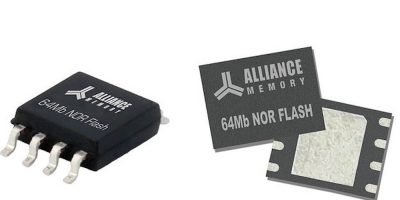Alliance Memory offers a new line of 3V multiple input/output serial NOR flash memory products designed to provide supply continuity for Micron Technology customers using discontinued N25Q series devices. Offering support for single, dual, and quad SPI modes, the AS25F series combines fast read performance up to 104MHz with fast program and erase times of 0.3ms and 40ms typical, respectively.
Available in 8-pin SOP wide body (209mils) and 8L WSON (6x5mm) packages, the devices operate from a single 2.7V to 3.6V power supply over an industrial temperature range of -40 degrees C to +85 degrees C. The solutions offer typical erase/program currents of 20mA and maximum read currents of 25mA at 104MHz, and they are said by Alliance Memory to provide reliable, long-term performance with 100,000 program/erase cycles and 10-year data retention.
AS25F series devices support uniform 4KB or 32KB or 64KB erase, offers an 8/16/32/64byte wrap-around burst read mode, and features program/erase suspend and resume. Advanced security features include block protection and 4K-bit secured OTP to protect content from hostile access and inadvertent programming and erasing.
With their enhanced performance, the serial NOR flash memory products are designed to meet the demands of the computer, consumer, communications, IoT and mobile markets. The devices are suitable for use in, among others, chipsets for PCs, DVD and Blu-ray players, wireless LANs and cable modems, printers, set-top boxes, LCD displays, mobile and wearable devices, digital cameras, handheld GPS units and smart meters.
Samples and production quantities of the 3V serial NOR flash memory products are available now, with lead times of 16 to 20 weeks.
Alliance Memory is a global provider of critical and hard-to-find memory ICs for the communications, computing, consumer electronics, medical, automotive, and industrial markets. The company’s product range includes flash, DRAM, and SRAM memory ICs with commercial, industrial, and automotive operating temperature ranges and densities from 64Kb to 8Gb. Privately held, Alliance Memory maintains headquarters in Kirkland, Washington, and regional offices in Europe, Asia, Canada and South America.







